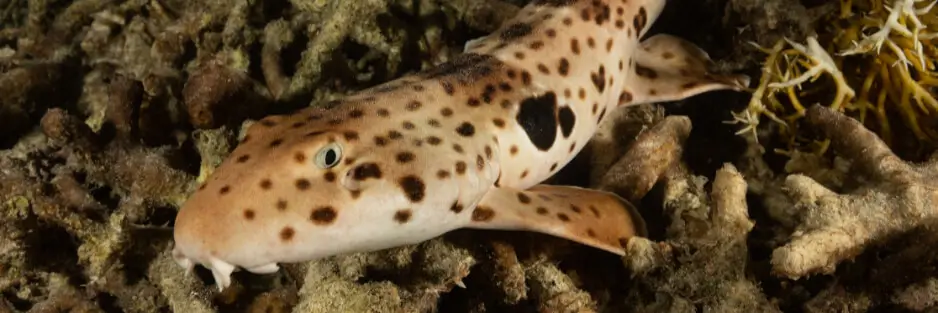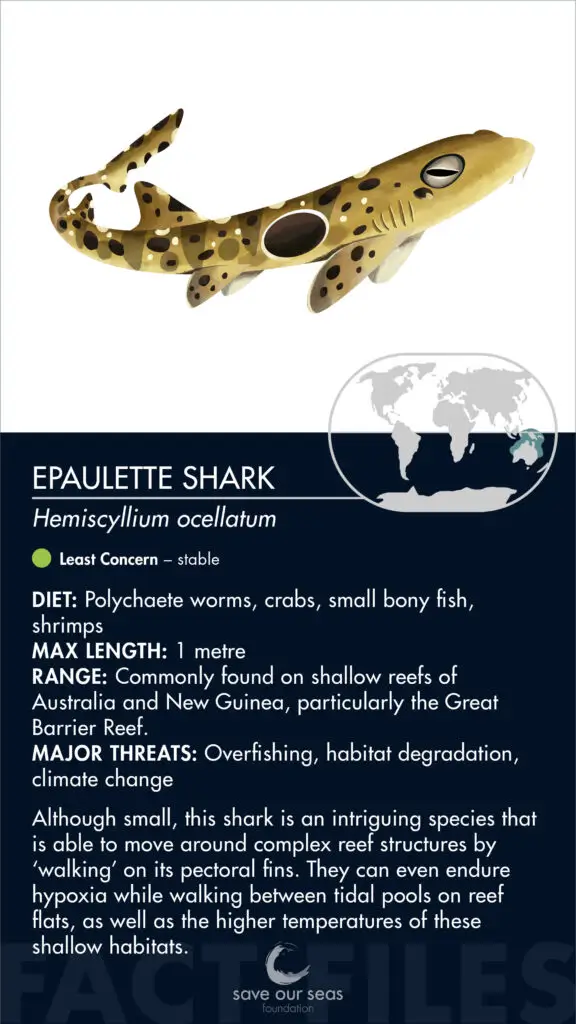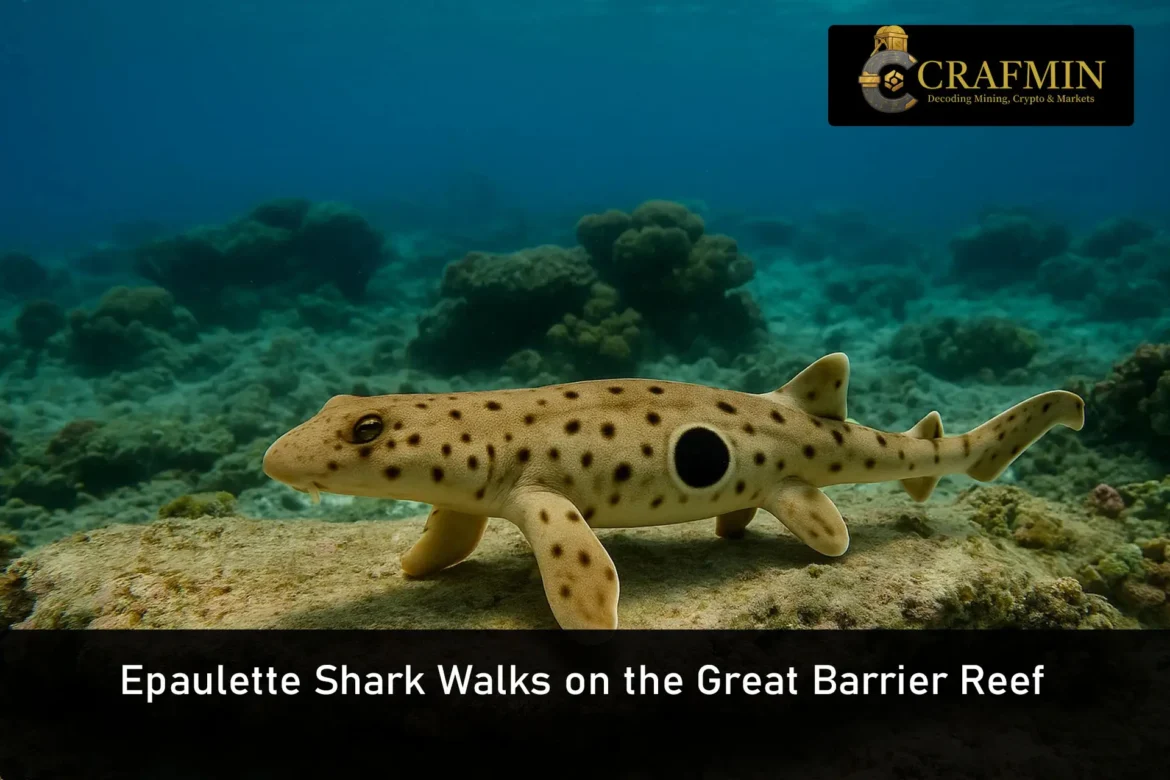A tiny reef-loving predator generates awe in scientists and divers. The epaulette shark of the Great Barrier Reef is said to cruise across the seabed. This evolutionary wonder walks over the coral flats, using fins as legs, seeking food and shelter.
It would not just be an extraordinary display of evolution but would also mark the health of our oceans. As the Great Barrier Reef suffers under the hand of climate change, the endurance and weaknesses of these sharks will be a hint toward what lies ahead for the reef ecosystem.

Walking across coral, the epaulette shark stuns scientists with its fin-powered stroll on the Great Barrier Reef.
How does the epaulette shark survive without oxygen?
The ability of this shark to remain unintoxicated for some hours due to a lack of oxygen is quite remarkable. Epaulettes shark gets trapped in a near-anoxic state in the tide pools during low tide. It causes a dilation of the blood vessel, thereby allowing greater oxygenated blood to flow into its body. This mechanism seems very different from how arteries constrict and dilate to change blood flow within the human circulatory system. Perturbations in their tunica media, a muscular layer situated between an outer connective tissue layer and an inner endothelial layer of the blood vessels, are of significant importance to this adaptation.
The shark will also shut down brain activity when it feels unnecessary. This biological slowed-down effect on vital systems is analogous to slowed heartbeats in survival through extreme cold. So, the shark “sleeps” through low tide until oxygen comes back up.
View this post on Instagram
Why can this shark walk on the reef?
In contrast to other sharks, the epaulette shark has evolved paddle-like pectoral and pelvic fins. They act like limbs, enabling the shark to “walk” over coral rubble.
This movement aids in the hunting activity that takes place in tight spaces where larger predators cannot reach. It opens intertidal food sources to this species that cannot be explored by others. The ability to move in such a manner is crucial for survival on the Great Barrier Reef.
Being able to withstand both low oxygen and temporary land exposure might provide some clues about early vertebrate evolution.Walking epaulette is the experimental connection nature created to traverse between the terrestrial and the marine realms.

Fact Sheet on Walking Shark
What risks does climate change pose to this species?
If listed as Least Concern by the IUCN, you wouldn’t say the epaulette shark is entirely free from environmental hazards. Warmer waters cause lower oxygen levels in the shallow pools. Such prevents the functioning ability of blood vessels in these sharks: for example, tunica externa (adventitia) resisting stresses on the vessel wall.
Temperature also affects egg development. Eggs incubated in warmer waters were found to yield smaller, weaker pups, leading to concerns about atherosclerosis-like impacts in shark physiology; hardened or inflamed arteries can diminish survival rates. The scientists fear that, with rising ocean temperatures, these sharks may not adapt fast enough to maintain healthy populations along the Great Barrier Reef.
Reef Damage Disrupts Marine Circulation
The Great Barrier Reef operates much like a big circulatory system. The coral structures are the vessels; water is the blood, with animals like the epaulette shark functioning like blood cells, maintaining the balance.
These sharks feed on worms, small fish, and crustaceans. They keep population numbers of invertebrates down to some extent, maintaining ecological balance. With the extinction of sharks, the entire food web would have been on its way to destruction.
The analogy is so perfect: cut off one “artery,” and the whole system is compromised. Just as in human beings, a blocked vessel places strain upon the heart. Thus, the biodiversity defines the very heart of the reef.
What conservation steps can help?
Conservation efforts need to be directed toward shallow reef flats and, more importantly, breeding grounds. Protection must be afforded to these areas from overfishing and dredging.
Increase the number of no-take zones within marine parks as a means to limit human activities. In addition, temperature and oxygen data need to be monitored around shark habitats. Genetic studies also indicate unique populations in the southern Great Barrier Reef, which may be genetically different enough to justify regional protection.
Gain insight into how the tunica media and tunica externa layers operate under stress could aid biologists in designing strategies for protection. If some individuals are resistant to warming, this might be important for leading conservation breeding work.
Also Read: UK Partners with OpenAI to Build National Tech Hopes
Can science and policy work together?
Yes — but time is limited! Epaulette sharks teach us: once a set of adaptations has been gained, it is not unlimited; if the environment changes too fast, even the most evolved species cannot cope.
The scientists and policymakers must team up. Laws for reef protection must be informed by data coming from research on oxygenated blood flow, degradation of carbonate reefs, and climate change. Public education in Queensland and other coastal areas may build support for grassroots conservation.
Walking sharks conservation implies rescuing a species and simultaneously maintaining the Great Barrier Reef, considered by many the living artery of Australia.

